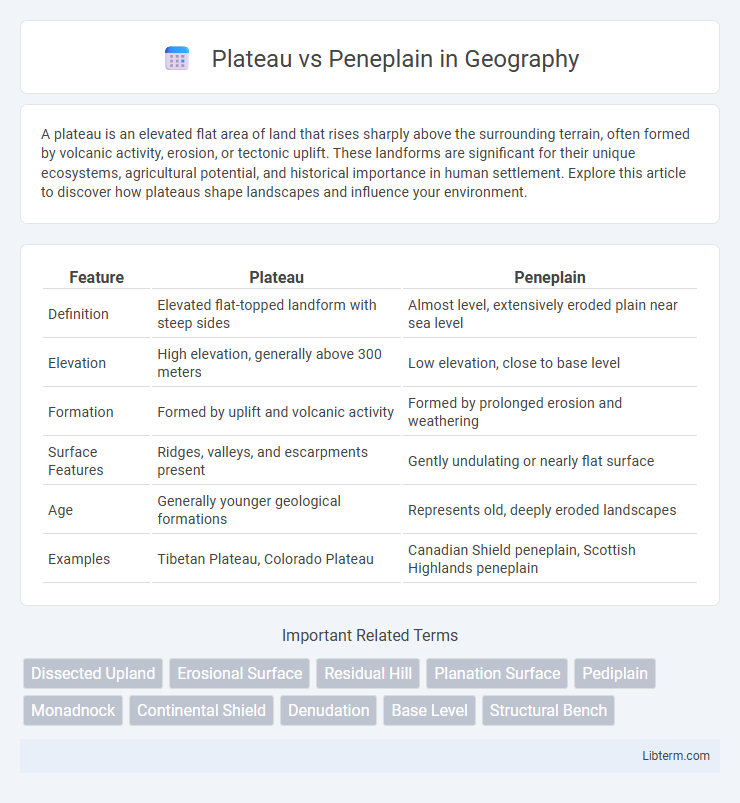A plateau is an elevated flat area of land that rises sharply above the surrounding terrain, often formed by volcanic activity, erosion, or tectonic uplift. These landforms are significant for their unique ecosystems, agricultural potential, and historical importance in human settlement. Explore this article to discover how plateaus shape landscapes and influence your environment.
Table of Comparison
| Feature | Plateau | Peneplain |
|---|---|---|
| Definition | Elevated flat-topped landform with steep sides | Almost level, extensively eroded plain near sea level |
| Elevation | High elevation, generally above 300 meters | Low elevation, close to base level |
| Formation | Formed by uplift and volcanic activity | Formed by prolonged erosion and weathering |
| Surface Features | Ridges, valleys, and escarpments present | Gently undulating or nearly flat surface |
| Age | Generally younger geological formations | Represents old, deeply eroded landscapes |
| Examples | Tibetan Plateau, Colorado Plateau | Canadian Shield peneplain, Scottish Highlands peneplain |
Introduction to Plateau and Peneplain
A plateau is an elevated flatland that rises sharply above the surrounding area, often formed by volcanic activity or tectonic uplift. A peneplain represents a nearly level land surface created by prolonged erosion, approaching base-level equilibrium. Understanding the differences between plateau and peneplain highlights variations in geological processes and landscape evolution.
Definition of Plateau
A plateau is a flat or gently undulating elevated landform that rises sharply above the surrounding area, often formed by volcanic activity, tectonic uplift, or erosion resistance. It is characterized by extensive horizontal surfaces and can span thousands of square kilometers. Plateaus differ from peneplains, which are nearly level landforms representing eroded remnants of ancient mountain ranges approaching a base level.
Definition of Peneplain
A peneplain is an extensive, nearly level land surface produced by prolonged erosion and denudation, approaching a base level close to sea level, characterized by gentle slopes and minimal relief. Unlike a plateau, which is a raised, flat-topped area with significant elevation and steep edges, a peneplain represents the end stage of erosion where the landscape has been worn down almost to a plain. The formation of peneplains involves long-term geological processes such as weathering, stream incision, and sediment transport, resulting in a broad, subdued topography.
Formation Processes of Plateaus
Plateaus form primarily through tectonic uplift, volcanic activity, or the accumulation of lava flows that create elevated flat regions. Unlike peneplains, which develop over long periods through extensive erosion and weathering that reduce landscapes to near-level plains, plateaus maintain their elevation due to resistant rock layers or ongoing tectonic forces. The distinctive formation of plateaus involves both the uplift of crustal blocks and deformation linked to mountain-building events, preserving their high elevation and relatively flat surface.
Formation Processes of Peneplains
Peneplains form through prolonged erosion, where rivers and weathering gradually reduce elevated landforms to near sea level over geological time scales. This process involves the gradual wearing down of mountains and plateaus, creating a gently undulating landscape with minimal relief. Unlike plateaus that result from tectonic uplift or volcanic activity, peneplains represent an advanced stage of landscape evolution marked by extensive denudation.
Key Geographical Features: Plateau vs Peneplain
Plateaus are elevated flat-topped landforms with steep sides, characterized by significant altitude above the surrounding terrain, often formed by tectonic uplift or volcanic activity. Peneplains represent nearly level land surfaces formed through prolonged erosion, typically at low elevations, indicating an advanced stage of landscape evolution. While plateaus retain distinct elevation and rugged relief, peneplains exhibit subdued relief with minimal elevation differences, reflecting extensive denudation processes.
Differences in Elevation and Relief
Plateaus are elevated flat-topped landforms that rise sharply above the surrounding terrain, typically with significant relief due to steep slopes or cliffs. Peneplains represent almost level surfaces formed by prolonged erosion, resulting in minimal relief with elevations closely matching adjacent landscapes. The key difference lies in elevation, where plateaus maintain high altitude and distinct relief, while peneplains approach near-flatness at low elevation with subdued topography.
Ecological and Climatic Impacts
Plateaus, with their elevated and flat terrain, influence local climate by promoting cooler temperatures and increased precipitation due to orographic lift, which supports diverse ecosystems adapted to these conditions. Peneplains, characterized by their nearly level surfaces formed through long-term erosion, often experience more uniform climatic conditions that support widespread, homogenous vegetation and soil types. The ecological impacts differ as plateaus foster habitat diversity and microclimates, while peneplains generally facilitate stable, extensive ecosystems shaped by gradual climatic and erosional processes.
Notable Examples Around the World
The Colorado Plateau in the United States exemplifies a plateau with its extensive elevated flat terrain shaped by tectonic uplift, while the Canadian Shield represents a classic example of a peneplain characterized by vast, gently undulating surfaces formed through prolonged erosion. The Deccan Plateau in India showcases volcanic plateau features elevated above surrounding regions, contrasting with the African Peneplain spanning parts of Southern Africa, notable for its ancient, eroded landscape nearing sea level. These landforms illustrate distinct geomorphological processes, with plateaus maintaining notable elevation and peneplains exhibiting nearly leveled topography due to extensive weathering.
Conclusion: Plateau vs Peneplain Analysis
A plateau is an elevated flatland with significant relief, formed by tectonic uplift or volcanic activity, whereas a peneplain represents an almost featureless, gently undulating surface formed by prolonged erosion and denudation. The key difference lies in their genesis and topographic expression: plateaus are structurally elevated landscapes, while peneplains indicate advanced stages of landscape leveling. Consequently, analyzing Plateau vs Peneplain involves understanding their distinct formation processes and geomorphological characteristics critical to interpreting Earth's surface evolution.
Plateau Infographic

 libterm.com
libterm.com